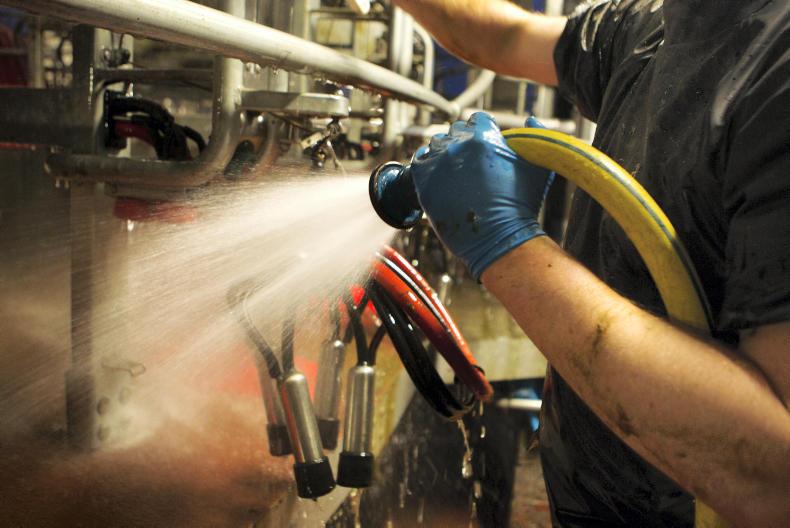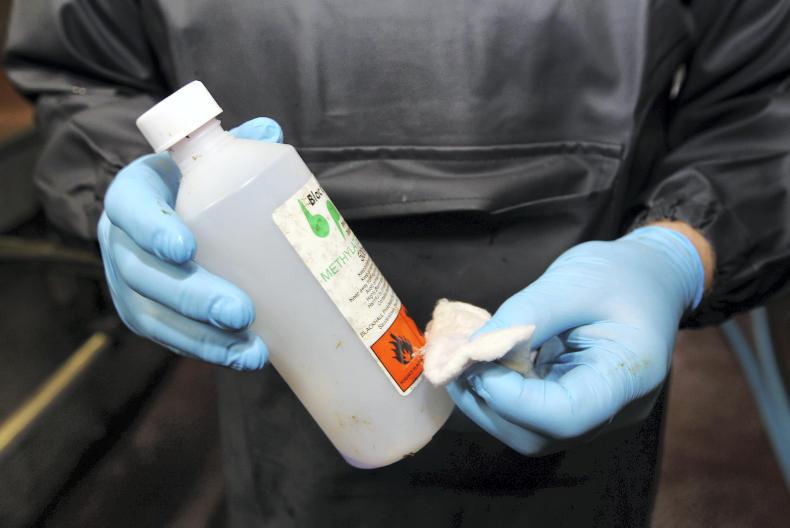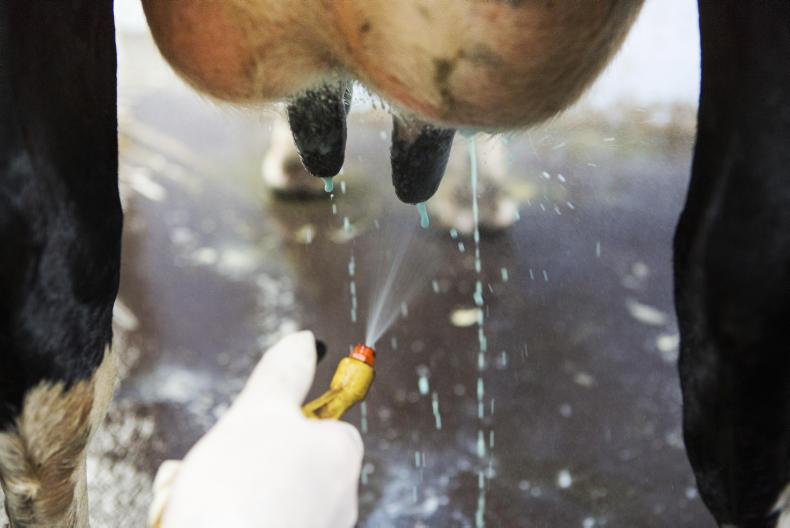Drying off cows is a great time to look ahead for winter health planning. In terms of udder health, it is a time to treat existing old infections and also to prevent new infections.
A good dry period can make a huge difference to the health of your herd.
With a move in the future for all dairy farms to start incorporating selective dry cow therapy (treating only udders and cows that need antibiotics), it is a good time to focus on somatic cell count (SCC) control on those farms that are not yet ready.
Drying off is one important step in this process. You simply must have a plan for your farm and your milk quality at drying off. So here are 10 tips:
1 If not milk recording, you should start. It is critical for monitoring individual cows’ SCC (infections in udders) and also it can tell us a great deal around breeding or selecting the next generation and spotting passengers.
A milk recording close to drying off will allow us pick out high-cell-count cows for a possible culture of quarters.
Culturing means getting the milk analysed to see what bugs are present and sensitivity testing allows us to see which dry cow antibiotics we might use.
2 Picking the right tube for your herd can be done in several ways – price, suitable withdrawal, previous success.
The most effective strategy is to pick a tube that suits the bugs in your herd.
Farmers can freeze mastitis samples throughout the year
This means getting problem cows with high SCCs and sampling them three weeks out from drying off and also checking some clinical mastitis samples.
Farmers can freeze mastitis samples throughout the year and then submit them before drying off to get a full picture of the bugs they are facing. Work with your vet to pick the right dry cow tube for your herd.
3 As milk yield decreases, the risk of winter herd SCC problems rise. In the last weeks of lactation, particularly when cows are indoors, we need to focus more than ever on good hygiene and milking routine.
Make sure the teat dip is suitable for the challenge and don’t spare it – 15ml (spraying) or 10ml (dipping) per milking means for 100 cows in a week you would use 21l minimum (spraying) and 14l for dipping.
Clip tails early if cows are indoors. It helps with hygiene around drying off
If cows are indoors, some farms experiencing a spike in clinical mastitis should consider pre-dipping; if SCC rises, ensure the teat dip itself is suitable.
A more viscous (thicker) teat dip works well for winter. Also, clip tails early if cows are indoors. It helps with hygiene around drying off.
4 Review the effectiveness of current treatments. We use antibiotics to treat high-cell-count cows but also to treat clinical mastitis.
It is important to record all treatments and cows. It is even more important to review treatment results – are they working? This is also really important when reviewing milk records before and after drying off.
Ensure we are treating old infections correctly and preventing new ones in some cases with blanket dry cow therapy.
We must also be mindful that will be some somatic cell count problems or udders (quarters) with very poor treatment outcomes.
This means the chances of treatment success are poor, especially with staph aureus repeat offenders. To get the best results, start recording and reviewing for better decision-making.
5 Drying off should be like a surgical procedure. Every farm should strongly consider using sealers in conjunction with dry cow antibiotics.
Where farmers are using no antibiotics, I feel sealers are a must to help prevent infections in the dairy cow indoors.
The actual drying-off procedure must be done slowly and correctly after milking. Don’t rush it. Have a sound plan based around hygiene.
Common mistakes are drying off cows during milking, poor milker (hand hygiene) and poor udder preparation.

Wash down the parlour between milking and drying off cows.
6 Cows should be abruptly dried off and have them at under 12l to 14l a day.
Straw in the diet helps pull the energy handbrake for a week before drying off. It also makes faeces more firm, which helps environmental hygiene.
Wash down the parlour first and, importantly, dry cows off separately to milking. If you’re doing it on your own, 25 cows is enough at the one time.
Get help where possible as any infections or poor drying off technique can cost your business thousands for the next lactation. I view drying off cows as similar to a surgical technique.
7 The process itself is about hygiene, hygiene and more hygiene. Wash your milking apron the night before.
Have your tools laid out and give yourself time. Use large cotton wool balls and plenty of methylated spirits.

Teat ends use alcohol or methylated spirits to disinfect
Start by pre-dipping all four quarters and use disposable paper towels to dry.
For each cow, have a big cotton wool ball soaked in alcohol spirits. Make it into a cube shape and use one side for each teat.
Focus your hygiene on the teat end and have alcohol gel to wash hands (gloves) between cows.
A case of bacteria entering the udder at drying off can affect a cow for up to five months after calving
Start on back left, then do the back right and around to the front two teats.
A handy tip is to put on four to five pairs of disposable gloves and remove a pair every time they get dirty.
A case of bacteria entering the udder at drying off can affect a cow for up to five months after calving. This is serious business. Let’s get it right.
When the antibiotic is administered, massage it up into the udder. This should be avoided where hands are getting dirtier in the process.
Then move onto the sealer.
8 Do we need to use sealer? The answer is yes. In conjunction with antibiotics and with selective dry cow therapy it is a must.

Hygiene at drying off needs to be like a surgery with strict asepsis at the teat end.
With sealers, be careful to not put them in hot water to make it easier to use – hot water in buckets can harbour bacteria.
They need to fill the teat canal so hold the base of the teat when applying them. Some first-lactation animals might have small teats so don’t worry if you don’t use the full syringe.
9 Post drying off the cows are at risk for seven to 10 days while the teat seals and the udder involutes.
The first 48 hours are critical and we must provide a clean and dry lie for the udder. The challenge in Ireland is our damp winters and some silages can make faeces more liquid.
The wet weather has meant most cows will be housed after drying off
Sheds need to be well ventilated, scrapers must be run regularly and straw in the diet helps change the consistency of dung around drying off. This drier dung can make cow beds cleaner.
For most farms, though, it is about cleaning cubicles and liming regularly. The wet weather has meant most cows will be housed after drying off.
Watch cows carefully for the first days after housing for any udder swelling or sickness.
10 Have a long-term plan – selective dry cow therapy is something every farm needs to be working towards.
A good drying-off procedure will allow farms eligible to start selective dry cow therapy to tackle the challenge head on.
After calving and when your first milk recording of 2020 is done, it is a great time to look at how effective dry cow treatment and the dry period were at treating old infections and not having new ones occur.
Drying off cows is a great time to look ahead for winter health planning. In terms of udder health, it is a time to treat existing old infections and also to prevent new infections.
A good dry period can make a huge difference to the health of your herd.
With a move in the future for all dairy farms to start incorporating selective dry cow therapy (treating only udders and cows that need antibiotics), it is a good time to focus on somatic cell count (SCC) control on those farms that are not yet ready.
Drying off is one important step in this process. You simply must have a plan for your farm and your milk quality at drying off. So here are 10 tips:
1 If not milk recording, you should start. It is critical for monitoring individual cows’ SCC (infections in udders) and also it can tell us a great deal around breeding or selecting the next generation and spotting passengers.
A milk recording close to drying off will allow us pick out high-cell-count cows for a possible culture of quarters.
Culturing means getting the milk analysed to see what bugs are present and sensitivity testing allows us to see which dry cow antibiotics we might use.
2 Picking the right tube for your herd can be done in several ways – price, suitable withdrawal, previous success.
The most effective strategy is to pick a tube that suits the bugs in your herd.
Farmers can freeze mastitis samples throughout the year
This means getting problem cows with high SCCs and sampling them three weeks out from drying off and also checking some clinical mastitis samples.
Farmers can freeze mastitis samples throughout the year and then submit them before drying off to get a full picture of the bugs they are facing. Work with your vet to pick the right dry cow tube for your herd.
3 As milk yield decreases, the risk of winter herd SCC problems rise. In the last weeks of lactation, particularly when cows are indoors, we need to focus more than ever on good hygiene and milking routine.
Make sure the teat dip is suitable for the challenge and don’t spare it – 15ml (spraying) or 10ml (dipping) per milking means for 100 cows in a week you would use 21l minimum (spraying) and 14l for dipping.
Clip tails early if cows are indoors. It helps with hygiene around drying off
If cows are indoors, some farms experiencing a spike in clinical mastitis should consider pre-dipping; if SCC rises, ensure the teat dip itself is suitable.
A more viscous (thicker) teat dip works well for winter. Also, clip tails early if cows are indoors. It helps with hygiene around drying off.
4 Review the effectiveness of current treatments. We use antibiotics to treat high-cell-count cows but also to treat clinical mastitis.
It is important to record all treatments and cows. It is even more important to review treatment results – are they working? This is also really important when reviewing milk records before and after drying off.
Ensure we are treating old infections correctly and preventing new ones in some cases with blanket dry cow therapy.
We must also be mindful that will be some somatic cell count problems or udders (quarters) with very poor treatment outcomes.
This means the chances of treatment success are poor, especially with staph aureus repeat offenders. To get the best results, start recording and reviewing for better decision-making.
5 Drying off should be like a surgical procedure. Every farm should strongly consider using sealers in conjunction with dry cow antibiotics.
Where farmers are using no antibiotics, I feel sealers are a must to help prevent infections in the dairy cow indoors.
The actual drying-off procedure must be done slowly and correctly after milking. Don’t rush it. Have a sound plan based around hygiene.
Common mistakes are drying off cows during milking, poor milker (hand hygiene) and poor udder preparation.

Wash down the parlour between milking and drying off cows.
6 Cows should be abruptly dried off and have them at under 12l to 14l a day.
Straw in the diet helps pull the energy handbrake for a week before drying off. It also makes faeces more firm, which helps environmental hygiene.
Wash down the parlour first and, importantly, dry cows off separately to milking. If you’re doing it on your own, 25 cows is enough at the one time.
Get help where possible as any infections or poor drying off technique can cost your business thousands for the next lactation. I view drying off cows as similar to a surgical technique.
7 The process itself is about hygiene, hygiene and more hygiene. Wash your milking apron the night before.
Have your tools laid out and give yourself time. Use large cotton wool balls and plenty of methylated spirits.

Teat ends use alcohol or methylated spirits to disinfect
Start by pre-dipping all four quarters and use disposable paper towels to dry.
For each cow, have a big cotton wool ball soaked in alcohol spirits. Make it into a cube shape and use one side for each teat.
Focus your hygiene on the teat end and have alcohol gel to wash hands (gloves) between cows.
A case of bacteria entering the udder at drying off can affect a cow for up to five months after calving
Start on back left, then do the back right and around to the front two teats.
A handy tip is to put on four to five pairs of disposable gloves and remove a pair every time they get dirty.
A case of bacteria entering the udder at drying off can affect a cow for up to five months after calving. This is serious business. Let’s get it right.
When the antibiotic is administered, massage it up into the udder. This should be avoided where hands are getting dirtier in the process.
Then move onto the sealer.
8 Do we need to use sealer? The answer is yes. In conjunction with antibiotics and with selective dry cow therapy it is a must.

Hygiene at drying off needs to be like a surgery with strict asepsis at the teat end.
With sealers, be careful to not put them in hot water to make it easier to use – hot water in buckets can harbour bacteria.
They need to fill the teat canal so hold the base of the teat when applying them. Some first-lactation animals might have small teats so don’t worry if you don’t use the full syringe.
9 Post drying off the cows are at risk for seven to 10 days while the teat seals and the udder involutes.
The first 48 hours are critical and we must provide a clean and dry lie for the udder. The challenge in Ireland is our damp winters and some silages can make faeces more liquid.
The wet weather has meant most cows will be housed after drying off
Sheds need to be well ventilated, scrapers must be run regularly and straw in the diet helps change the consistency of dung around drying off. This drier dung can make cow beds cleaner.
For most farms, though, it is about cleaning cubicles and liming regularly. The wet weather has meant most cows will be housed after drying off.
Watch cows carefully for the first days after housing for any udder swelling or sickness.
10 Have a long-term plan – selective dry cow therapy is something every farm needs to be working towards.
A good drying-off procedure will allow farms eligible to start selective dry cow therapy to tackle the challenge head on.
After calving and when your first milk recording of 2020 is done, it is a great time to look at how effective dry cow treatment and the dry period were at treating old infections and not having new ones occur.









 This is a subscriber-only article
This is a subscriber-only article









SHARING OPTIONS: